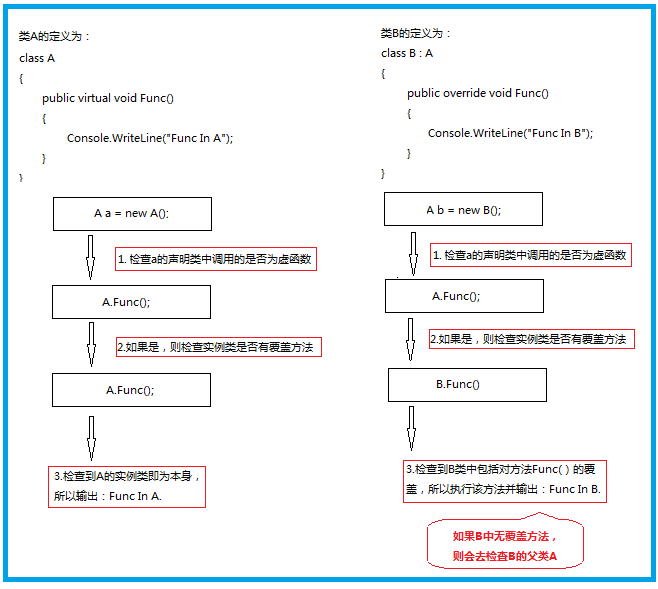要學好C#,基礎知識的重要性不言而喻,現將常用到的一些基礎進行總結,總結如下:
01. 數據類型轉換:
強制類型轉換(Chart--> int):
?char cr='A'; ??int i = (int)(cr);
02. 委托/匿名函數/Lamda表達式:
? ? 委托是匿名函數的起源,Lamda表達式又是匿名函數的升華。這些又是如何體現的呢,請看:
? ? 委托示例:


namespace Delegate {class Program{public delegate void TDelegate(int i, int j);static void Caculator(int i, int j){Console.WriteLine(i * j * i * j);}public static void InvokeDE(){TDelegate td = new TDelegate(Caculator);td.Invoke(3, 5);}static void Main(string[] args){InvokeDE();Console.ReadLine();}} }
? ? 匿名函數示例:


using System; using System.Collections.Generic; using System.Linq; using System.Text; using System.Threading.Tasks;namespace CSP {class Program{public delegate void MyDelegate(int x, int y);static void Main(string[] args){MyDelegate md = delegate(int x, int y){Console.WriteLine(x + y);};md(10, 100);Console.ReadLine();}} }
? ?Lamda表達式(實際就是一個函數)示例:


using System; using System.Collections.Generic; using System.Linq; using System.Text; using System.Threading.Tasks;namespace CSP {class Program{private static void LamdaExpression(){int[] InitArr = { 1, 2, 3, 4, 5, 6, 7, 8, 9, 10 };int ResCount = InitArr.Where(n => n > 6).Count();Console.WriteLine(ResCount);}static void Main(string[] args){LamdaExpression();Console.ReadLine();}} }
03. 泛型Gereric:
? ??泛型是C#一個非常重要的用法,必須熟記于心:


using System; using System.Collections.Generic; using System.Linq; using System.Text; using System.Threading.Tasks;namespace CSP {class Program{public static void GenericFunction(){int i = 10;string HI = "Hello World!";TestGC<int> tg_int = new TestGC<int>(i);TestGC<string> tg_string = new TestGC<string>(HI);Console.WriteLine(tg_int.t.ToString());Console.WriteLine(tg_string.t.ToString());}static void Main(string[] args){GenericFunction();Console.ReadLine();}}public class TestGC<T>{public T t;public TestGC(T t){this.t = t;}} }
04. ?虛方法Virtual:
? ? ?以前總覺得自己掌握的很好了,最近看了一些文章才對Virtual的執行順序有了更深的理解,為了加深印象,我添加了示例圖并特地將本篇文章在此處進行了引用:


class A {public virtual void Func() // 注意virtual,表明這是一個虛擬函數 {Console.WriteLine("Func In A");} } class B : A // 注意B是從A類繼承,所以A是父類,B是子類 {public override void Func() // 注意override ,表明重新實現了虛函數 {Console.WriteLine("Func In B");} } class C : B // 注意C是從B類繼承,所以B是父類,C是子類 { } class D : A // 注意D是從A類繼承,所以A是父類,D是子類 {public new void Func() // 注意new,表明覆蓋父類里的同名類,而不是重新實現 {Console.WriteLine("Func In D");} } class E : D // 注意E是從D類繼承,所以D是父類,E是子類 {} class F : A {private new void Func() //注意new關鍵字前有private修飾符,故該隱藏只在F類內有效 {Console.WriteLine("Func In F");}public void Func2() {Func(); //在F類內隱藏了基類的Func方法,故此處調用的private new void Func() } }static void Main(string[] args) {A a; // 定義一個a這個A類的對象.這個A就是a的申明類 A b; // 定義一個b這個A類的對象.這個A就是b的申明類 A c; // 定義一個c這個A類的對象.這個A就是c的申明類 A d; // 定義一個d這個A類的對象.這個A就是d的申明類 A e; // 定義一個e這個A類的對象.這個A就是e的申明類 A f; // 定義一個f這個A類的對象.這個A就是f的申明類 a = new A(); // 實例化a對象,A是a的實例類 b = new B(); // 實例化b對象,B是b的實例類 c = new C(); // 實例化c對象,C是c的實例類 d = new D(); // 實例化d對象,D是d的實例類 e = new E(); // 實例化e對象,E是e的實例類f = new F(); // 實例化f對象,F是f的實例類Console.WriteLine("a.Func();");a.Func(); // 執行a.Func:1.先檢查申明類A 2.檢查到是虛擬方法 3.轉去檢查實例類A,就為本身 4.執行實例類A中的方法 5.輸出結果 Func In A Console.WriteLine("b.Func();");b.Func(); // 執行b.Func:1.先檢查申明類A 2.檢查到是虛擬方法 3.轉去檢查實例類B,有重載的 4.執行實例類B中的方法 5.輸出結果 Func In B Console.WriteLine("c.Func();");c.Func(); // 執行c.Func:1.先檢查申明類A 2.檢查到是虛擬方法 3.轉去檢查實例類C,無重載的 4.轉去檢查類C的父類B,有重載的 5.執行父類B中的Func方法 5.輸出結果 Func In B Console.WriteLine("d.Func();");d.Func(); // 執行d.Func:1.先檢查申明類A 2.檢查到是虛擬方法 3.轉去檢查實例類D,無重載的(這個地方要注意了,雖然D里有實現Func(),但沒有使用override關鍵字,所以不會被認為是重載) 4.轉去檢查類D的父類A,就為本身 5.執行父類A中的Func方法 5.輸出結果 Func In A Console.WriteLine("e.Func();");e.Func(); // 執行e.Func:E繼承D,E.Func沒有重寫父類中的方法,相當于執行父類D中的Func方法,輸出結果 Func In A Console.WriteLine("f.Func();");f.Func(); // 執行f.Func:F類中雖然隱藏了基類中的Func方法,但是有private修飾符,該隱藏只在F類范圍內有效。執行f.Func相當于執行其基類中的Func方法,輸出結果 Func In A D d1 = new D();Console.WriteLine("d1.Func();");d1.Func(); // 執行D類里的Func(),輸出結果 Func In D E e1 = new E();Console.WriteLine("e1.Func();");e1.Func(); // 執行E類里的Func(),輸出結果 Func In D F f1 = new F();Console.WriteLine("f1.Func();");f1.Func(); // 執行F類里的Func(),輸出結果 Func In AConsole.WriteLine("f1.Func2();");f1.Func2(); // 執行F類里的Func2(),輸出結果 Func In F Console.ReadLine(); }

05. New和Override的用法:
? ? New是新建一個新方法,對舊方法進行了屏蔽,而Override只是對父類中的方法進行了覆蓋,具體詳細用法參見4. Virtual用法示例;
06.?foreach用法:
? ? foreach遍歷訪問的對象需要實現IEnumerable接口或聲明GetEnumerator方法的類型;
MSDN上的例子:


using System; using System.Collections; using System.Collections.Generic; using System.Linq; using System.Text; using System.Threading.Tasks;namespace CSP {public class Person{public string firstName;public string lastName;public Person(string fName, string lName){this.firstName = fName;this.lastName = lName;}}public class People : IEnumerable{private Person[] _people;public People(Person[] pArray){_people = new Person[pArray.Length];for (int i = 0; i < pArray.Length; i++){_people[i] = pArray[i];}}// Implementation for the GetEnumerator method. IEnumerator IEnumerable.GetEnumerator(){return (IEnumerator)GetEnumerator();}public PeopleEnum GetEnumerator(){return new PeopleEnum(_people);}}public class PeopleEnum : IEnumerator{public Person[] _people;int position = -1;public PeopleEnum(Person[] list){_people = list;}public bool MoveNext(){position++;return (position < _people.Length);}public void Reset(){position = -1;}object IEnumerator.Current{get{return Current;}}public Person Current{get{try{return _people[position];}catch (IndexOutOfRangeException){throw new InvalidOperationException();}}}}class App{static void Main(){Person[] peopleArray = new Person[3]{new Person("John", "Smith"),new Person("Jim", "Johnson"),new Person("Sue", "Rabon"),};People peopleList = new People(peopleArray);foreach (Person p in peopleList)Console.WriteLine(p.firstName + " " + p.lastName);Console.ReadLine();}} }
?下面例子是對上面的改動,只保留了對GetEnumerator()方法的實現,移除了對IEnumerable接口和IEnumerator接口的繼承,執行結果同上例一樣:


using System; using System.Collections; using System.Collections.Generic; using System.Linq; using System.Text; using System.Threading.Tasks;namespace CSP {public class Person{public string firstName;public string lastName;public Person(string fName, string lName){this.firstName = fName;this.lastName = lName;}}public class People{private Person[] _people;public People(Person[] pArray){_people = new Person[pArray.Length];for (int i = 0; i < pArray.Length; i++){_people[i] = pArray[i];}}public PeopleEnum GetEnumerator(){return new PeopleEnum(_people);}}public class PeopleEnum{public Person[] _people;int position = -1;public PeopleEnum(Person[] list){_people = list;}public bool MoveNext(){position++;return (position < _people.Length);}public Person Current{get{try{return _people[position];}catch (IndexOutOfRangeException){throw new InvalidOperationException();}}}}class App{static void Main(){Person[] peopleArray = new Person[3]{new Person("John", "Smith"),new Person("Jim", "Johnson"),new Person("Sue", "Rabon"),};People peopleList = new People(peopleArray);foreach (Person p in peopleList)Console.WriteLine(p.firstName + " " + p.lastName);Console.ReadLine();}} }
? ? PS.
A.實現實現IEnumerable接口的同時就必須實現IEnumerator接口;
? ? B.不一定要實現IEnumerable接口,但一定要實現GetEnumrator方法。
? ? 對于上述的功能,可以也嘗試使用語法糖(便捷寫法)C# yield來進行實現;
07.?靜態構造函數
靜態構造函數,也稱靜態代碼塊,主要用于初始化靜態變量,示例如下:


using System; using System.Collections.Generic; using System.Linq; using System.Text; using System.Threading.Tasks;namespace CSP {public class StaticBlock{public string Title;static StaticBlock(){Console.WriteLine("Here is the static block,only can be called for 1 time!");}public StaticBlock(string Title){this.Title = Title;}}class Program{static void Main(string[] args){StaticBlock sb_morning = new StaticBlock("Good morning!");Console.WriteLine(sb_morning.Title);StaticBlock sb_afternoon = new StaticBlock("Good afternoon!");Console.WriteLine(sb_afternoon.Title);Console.ReadLine();}} }
靜態構造函數具有如下特點(來自網絡):
A.靜態構造函數既無訪問修飾符亦無參數;
? ? B.如果沒有編寫靜態構造函數,而這時類中包含帶有初始值設定的靜態字段,那么編譯器會自動生成默認的靜態構造函數。
? ? C.在創建第一個類實例或任何靜態成員被引用時,.NET將自動調用靜態構造函數來初始化類,即無法直接調用與控制靜態構造函數。
? ? D.如果類中包含用來開始執行的 Main 方法,則該類的靜態構造函數將在調用 Main 方法之前執行。
? ? E.如果類中的靜態字段帶有初始化,則靜態字段的初始化語句將在靜態構造函數之前運行。
? ? F.一個類只能有一個靜態構造函數,不可以被繼承且最多只運行一次。
08. 【反射】typeof/GetType
typeof:獲取類運行時的類型及方法列表,參數只能為類名,用法typeof(類名);
? ??GetType:獲取類運行時的類型及方法列表,由對象調用,用法:obj.GetType();
09.?where T : class
?主要用來對接口進行限制,如下所示,限制接口IDataComponentBase<T>中的T必須為一個引用類型,如類,接口,數組;
public interface IDataComponentBase<T>?where T : class
10.?Guid對象賦值:
? ? Guid gd = new Guid("3a4f38a3-e064-e611-80d6-080027c84e1f");
11. Dispose():
? ??在使用using方法結束時會自動調用Dispose(),以便顯示釋放非托管資源(前提是該當前類必須實現接口:IDisposable);
12. 保留兩位小數:
? ? ? Decimal?OVNum,NCNum;
? ? ? ... ...
? ? ? Decimal TotNum = OVNum + NCNum;
? ? ? Decimal d = NCNum * 100 / TotNum;
? ? ? e.Result = Decimal.Round(d, 2);
13. 利用List自帶的Sort進行排序:


using System; using System.Collections.Generic; using System.Linq; using System.Text; using System.Threading.Tasks;namespace CA {class Program{static void Main(string[] args){List<Light> lts = new List<Light>();Light lt0 = new Light();lt0.LTypeName = "Filament";lt0.W = 12;Light lt1 = new Light();lt1.LTypeName = "Common";lt1.W = 25;Light lt2 = new Light();lt2.LTypeName = "Efficient";lt2.W = 50;lts.Add(lt0);lts.Add(lt1);lts.Add(lt2);Console.WriteLine("Before sort:");foreach (Light l in lts){Console.WriteLine(l.LTypeName+":"+l.W);}//A~Z//lts.Sort((x, y) => x.LTypeName.CompareTo(y.LTypeName));//Z~Alts.Sort((x, y) => -x.LTypeName.CompareTo(y.LTypeName));Console.WriteLine("After sort:");foreach (Light l in lts){Console.WriteLine(l.LTypeName + ":" + l.W);}Console.ReadLine();}}public class Light{public string LTypeName { get; set; }public int W { get; set; }} }
14.?數組,ArrayList,List的區別:
數組的優點是可以存儲多個維度的記錄,且連續存放,缺點是需要在定義時指定數組的長度,且定義好后不能擴展;
? ? ?ArrayList在定義時不需要指定長度也不需要定義存入的數據的數據類型,可以自由擴展。所以ArrayList可以存放不同類型的數據(以object存入,要進行裝箱操作)到ArrayList,所以ArrayList為非類型安全的;
? ? ?使用如下所示:
ArrayList al = new ArrayList();
al.Add(100);
al.Add("Hello");
?List與ArrayList一樣,在定義時不需要指定長度,可以自由擴展。同時,在聲明List時,需要定義存入的數據的數據類型,實現了類型安全;
?ArrayList的命名空間:System.Collections.ArrayList
? ? ?List的命名空間:System.Collections.Generic.List
15. const/readonly
關于C#還有更多內容需要研究,希望自己能再接再厲,繼續總結!
?

—— 使用pipeline數據保存到文本和數據庫(mysql)...)








簡單入門)







![[國嵌攻略][132][串口驅動實現]](http://pic.xiahunao.cn/[國嵌攻略][132][串口驅動實現])
